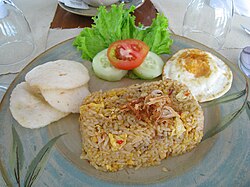Javanese-style of fried rice
Not to be confused with Java rice, a Filipino yellow-orange fried rice dish with turmeric or annatto.
 A plate of nasi goreng jawa from Surakarta, Central Java | |
| Course | Main course |
|---|---|
| Place of origin | Indonesia[1][2] |
| Region or state | Java |
| Associated cuisine | Indonesia[3] |
| Main ingredients | Fried rice with meats, vegetables, pickles, spices, sweet soy sauce, and sambal |
| Variations | Rich variations across the respective region |
Nasi goreng jawa (Indonesian for Javanese fried rice, Javanese: sega goreng jawa) is a Javanese-style of fried rice originated from Java, Indonesia. This dish can be found in Javanese cuisine and quite popular in Indonesia, especially Java. Commonly, this rice dish uses sambal ulek as seasoning and has a spicy taste.[4][5]
Variation[edit]
- Nasi goreng babat from Semarang which is slightly brown in color with tripe as a side dish.
- Nasi goreng Solo (Central Java) which is pink in color with a side dish of cabbage and shredded free-range chicken.
- Nasi goreng Surabaya which is red-brown in color, the portion is large, and slightly spicy with a side dish of sliced omelet and chicken.
- Nasi goreng kampung from Yogyakarta which is red in color with side dishes of sunny-side up eggs and free-range chicken.
See also[edit]
References[edit]
- ^ Andrea Chesman (1998). 366 Delicious Ways to Cook Rice, Beans, and Grains. Penguin. ISBN 9781101075746.
- ^ Stein, Rick. "Indonesian stir-fried rice (Nasi goreng)". BBC Food Recipes. Archived from the original on 19 August 2015. Retrieved 3 August 2015.
- ^ Media, Kompas Cyber. "Kemenpar Tetapkan 5 Makanan Nasional Indonesia, Ini Daftarnya". KOMPAS.com (in Indonesian). Retrieved 18 April 2018.
- ^ "Resep Cara Membuat Nasi Goreng Jawa Pedas Lezat". fimela.com. September 9, 2017.
- ^ "Javanese Fried Rice - Kitchenesia". kitchenesia.grid.id.
External links[edit]
| Dishes |
| ||||||||||||||||||||||||||||||||||||||||||||||||
|---|---|---|---|---|---|---|---|---|---|---|---|---|---|---|---|---|---|---|---|---|---|---|---|---|---|---|---|---|---|---|---|---|---|---|---|---|---|---|---|---|---|---|---|---|---|---|---|---|---|
| Snacks |
| ||||||||||||||||||||||||||||||||||||||||||||||||
| Beverages |
| ||||||||||||||||||||||||||||||||||||||||||||||||
| Bumbu |
| ||||||||||||||||||||||||||||||||||||||||||||||||
| Influences and overseas dishes |
| ||||||||||||||||||||||||||||||||||||||||||||||||
| List articles | |||||||||||||||||||||||||||||||||||||||||||||||||
| Related topics | |||||||||||||||||||||||||||||||||||||||||||||||||
Well, that’s interesting to know that Psilotum nudum are known as whisk ferns. Psilotum nudum is the commoner species of the two. While the P. flaccidum is a rare species and is found in the tropical islands. Both the species are usually epiphytic in habit and grow upon tree ferns. These species may also be terrestrial and grow in humus or in the crevices of the rocks.
View the detailed Guide of Psilotum nudum: Detailed Study Of Psilotum Nudum (Whisk Fern), Classification, Anatomy, Reproduction